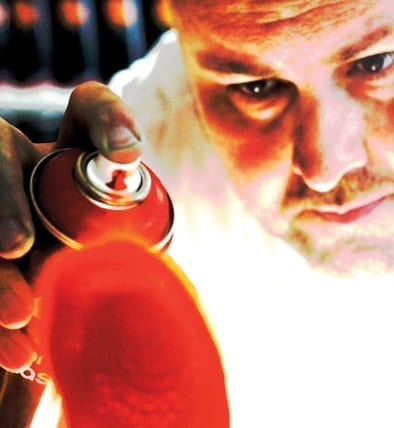Freshwater-based artist Steve Miles aka ‘Toxic’, reveals his street side to Tracy Curtis.
Whether you love or hate graffiti, these days there’s no denying its cultural and political relevance and the skill involved that has elevated this art form from street walls to galleries and museums across the globe.
Freshwater may seem an unlikely place to find one of the stalwarts of the UK’s graffiti scene, but it’s here that Steve Miles has landed; forsaking walls and quietly building up a collection of work on canvas to excite any contemporary art connoisseur.
Steve’s electrifying, vibrant, often abstract art is displayed throughout his house. Wife Rachael smiles, “We held a party recently and the neighbours were round. They didn’t really know what Steve did, and were blown away when they found out he painted all these.” Working in mixed media, using spray paint from his sponsor ‘Monster Colors’, acrylics, and sometimes oil pastels, he combines his passion for typography and colour to produce fine art with a street feel.
Steve was introduced to graffiti at 11 years old whilst living in Birmingham. “My next door neighbour’s cousin from America came to visit and showed us magazines about graffiti and hip hop. We used to mess about practicing breakdancing moves, and I’d always drawn so I really got into the graffiti. The idea of creating your own letter forms in bright colour schemes, rather than drawing wildlife or copying Disney characters was so different at the time, and it really stuck with me.” Aged 14, Steve generated an alter ego, ‘Toxic’, which has been his tag on legal graffiti walls up and down the country for the past 26 years. The simple reason behind his somewhat menacing moniker was that ‘Non-toxic’ was on the back of a marker pen he had been using, and he just liked the word.
At the bottom of the garden is Steve’s studio, his haven, filled with work in progress and shelves stacked high with multi-coloured spray cans and paints. Steve explains “Graffiti has always been my passion but it went on the back-burner for decade. I was getting married, buying a house, having a son and paying bills. I got back into it 10 years ago, after establishing Urbn Fabrik, a graffiti networking site connecting over 10,000 artists across the globe. Seeing their work opened my eyes a bit and made me wonder why I wasn’t doing stuff for myself any more.”
At his day job as a Graphic Designer, Steve was used to working to customers briefs and often didn’t have the creative energy left at the end of the day to work on his own projects. Since working more recently as a computer games artist, and surrounded by creative people he respects, he’s been inspired to spend more time in his studio.
A quick glance at his work doesn’t nearly do justice to the thought that goes into it. If you delve deeper you can begin to de-construct the colours and lines, discovering what lies beneath. The ‘eureka’ moment for his style came from the street, at a painting jam. “This wall must have been painted every week for 25 years by different artists, so a huge layer of paint had built up. We noticed rain had blistered a corner of it, so we chipped away and pulled a chunk off. It was like tearing plastic off the wall and left this great effect where you could see the different layers beneath. I wanted to try a technique to recreate this idea of several paintings underneath each other, and so this is what I’ve been developing. I build up the picture with darker colours first and work out to lighter ones. You can follow the coloured shapes round the painting to see the layering technique.”
A fellow graffiti artist and constant inspiration is Remi Rough, part of the UK’s abstract graffiti movement. “I love his composition; it looks really simple, but is very hard to recreate it yourself.” Other influences include Picasso, Franz Kline, Willem de Kooning and Ian Fairweather because, “They have a graphic appeal to them, the use of line and the way they construct their paintings.” Admiring the lines, colours and depth of layers in Steve’s art, you can instantly see the connections.
“With street graffiti, you have to work out exactly what you’ll be doing on the wall so you can take along the right colours and amount of paint needed. I like that on canvas it doesn’t have to be so pre-planned, although I do always have an idea at the start how the pieces will end up. Sometimes they turn out like my original vision, but often they are more free-form.”
He readily admits that it took him a while to get his head around scaling down from 30ft x 8ft walls to 3ft x 3ft canvas, and often gets the artists version of writer’s block. “A lot of my paintings have other paintings underneath because I’ve needed to get over ‘blank canvas syndrome.’ I just have to begin painting anything to fill the canvas up, and then use this as a building block before starting again.”
To date, Steve’s been reluctant to do anything publicly with his art, and remains far too modest about his talent. He doesn’t yet think he’s found himself with this new direction, and feels like he is still experimenting. “I’m not commercially driven because I have a good job at a good company, I just want to carry on doing what I enjoy and start to share it in the hope that others will like it. I paint for my own sanity, not for anyone else, it’s my stress reliever, but now that I have my studio and renewed creative drive, my next goal is to hold an exhibition.”
Hopefully exhibiting at a gallery near you soon, for now you can contact Steve at smile@stevemiles.co.uk.






